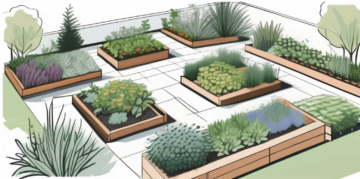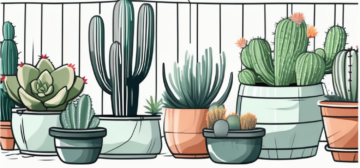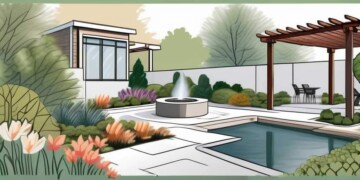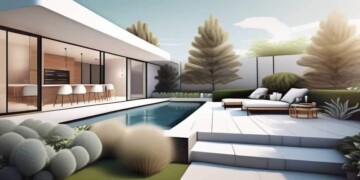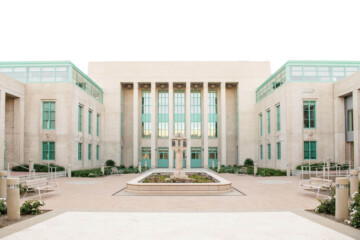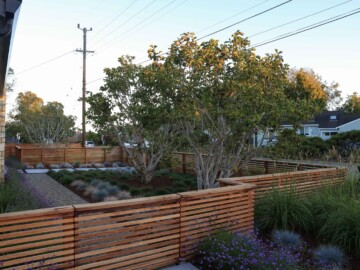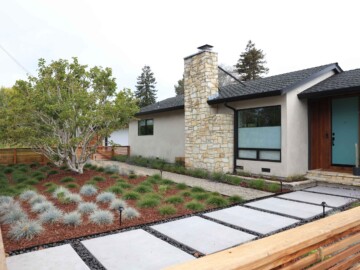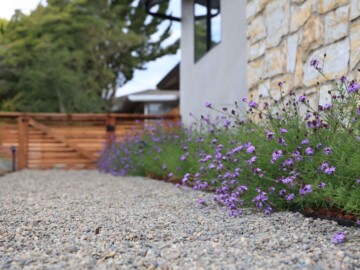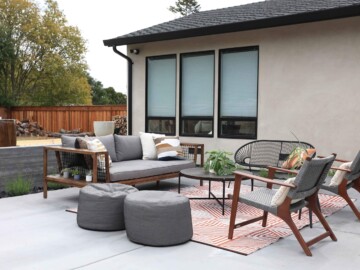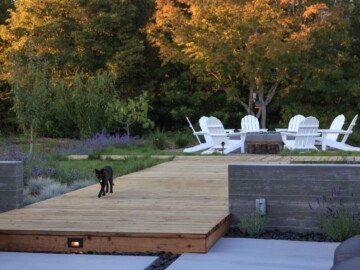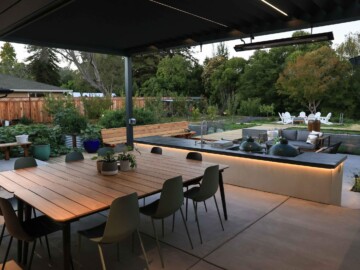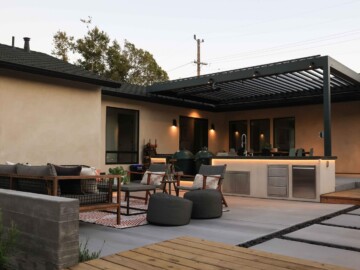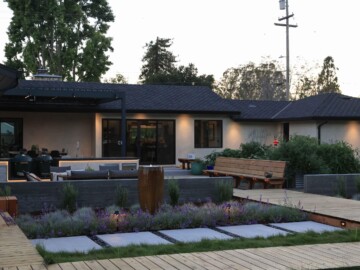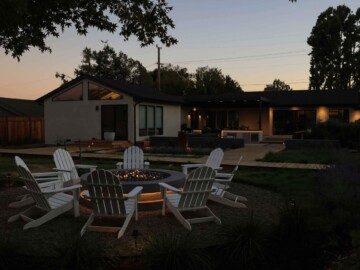Craft an Edible Garden Design with 4 Secrets from an Experienced Landscape Professional
In this article, we will explore the secrets to crafting an edible garden design that will not only be aesthetically pleasing but also provide bountiful harvests of delicious, homegrown produce. These secrets have been shared by an experienced landscape professional who has mastered the art of edible garden design. By implementing these secrets, you can create a sustainable and thriving garden that will bring joy and nourishment to your life.
Understanding the Basics of Edible Garden Design
Before diving into the secrets, it is crucial to have a strong foundation in understanding the basics of edible garden design. One essential aspect is soil quality.
Creating a thriving edible garden involves more than just planting seeds and watering them. It requires a deep understanding of the ecosystem you are trying to cultivate. By focusing on soil quality, you are setting the stage for a successful harvest. Healthy soil is teeming with beneficial microorganisms that help plants absorb nutrients efficiently, leading to robust growth and bountiful yields.
The Importance of Soil Quality
The quality of your soil plays a vital role in the success of your garden. It is important to ensure that your soil is rich in nutrients and has the right texture for plants to thrive. Conduct a soil test to assess its pH level and nutrient content and make any necessary amendments to improve its quality.
Understanding the composition of your soil can help you select the right plants for your garden. Some plants thrive in well-draining sandy soil, while others prefer the moisture-retaining properties of loamy soil. By tailoring your plant selection to your soil type, you can create a harmonious environment where each species can flourish.
Choosing the Right Location for Your Garden
The location of your edible garden is equally significant. Select a spot that receives at least six hours of sunlight each day and provides good drainage. Consider the proximity to your water source and accessibility for regular maintenance.
In addition to sunlight and water access, think about the microclimates within your garden space. Areas near walls or fences may create warm microclimates, ideal for heat-loving plants, while low-lying spots might be prone to frost pockets. By observing these nuances in your garden, you can strategically place your plants to optimize their growth and resilience to environmental stressors.
Secret 1: Incorporating Permaculture Principles
Permaculture principles are the foundation of sustainable garden design. Understanding and incorporating these principles will significantly enhance the productivity and resilience of your garden.
One key aspect of permaculture is the emphasis on observing and interacting with nature. By closely observing how natural ecosystems function, gardeners can learn valuable lessons on how to work with, rather than against, the natural environment. This approach helps in creating gardens that are not only productive but also in harmony with the surrounding ecosystem.
The Basics of Permaculture
Permaculture is a design philosophy that aims to create sustainable and self-sufficient ecosystems. It involves mimicking natural patterns and processes to create a harmonious and productive garden.
Central to permaculture design is the concept of zones, which are areas within the garden that are grouped based on the frequency of human interaction and maintenance required. By strategically placing plants and elements based on these zones, gardeners can optimize their time and energy while maximizing the benefits of their garden.
Benefits of Permaculture in Edible Gardens
When applied to edible garden design, permaculture principles promote biodiversity, conserve water, and minimize the need for synthetic inputs. This results in healthier plants and higher yields with less effort.
Permaculture encourages the use of companion planting, where mutually beneficial plant combinations are grown together. This practice not only helps in pest control and nutrient cycling but also fosters a more resilient and diverse ecosystem. By harnessing the power of these natural relationships, gardeners can create thriving edible gardens that are not only productive but also ecologically sustainable.
Secret 2: Utilizing Companion Planting
Companion planting is a technique that involves planting compatible plants together to enhance growth, deter pests, and maximize space utilization.
Companion planting is a fascinating and age-old practice that has been utilized by gardeners for centuries to create harmonious and mutually beneficial plant communities. By strategically pairing certain plants together, you can harness the power of nature to improve the health and productivity of your garden.
What is Companion Planting?
Companion planting is the practice of growing certain plants in close proximity to benefit one another. Some plants repel pests, while others attract beneficial insects or provide shade and support to neighboring plants. For example, planting marigolds alongside tomatoes can help deter nematodes, while interplanting basil with tomatoes can enhance the flavor of the fruit.
Companion planting is not only limited to vegetables but can also be extended to flowers and herbs. For instance, planting dill near cucumbers can attract predatory insects that feed on common cucumber pests, thus reducing the need for chemical pesticides.
How to Choose Companion Plants
When selecting companion plants, consider their compatibility in terms of nutrient needs, growth habits, and pest resistance. Research which plants have mutually beneficial relationships and plan your garden accordingly. By understanding the unique characteristics of each plant species, you can create a diverse and resilient ecosystem within your garden that thrives without the need for excessive intervention.
Secret 3: Implementing Crop Rotation
Crop rotation is a technique that involves systematically changing the location of crops each season to improve soil health and reduce the risk of pest and disease buildup.
The Role of Crop Rotation in Soil Health
Crop rotation plays a crucial role in maintaining soil health and promoting sustainable agriculture practices. By diversifying the types of crops grown in a particular area over time, farmers can prevent the depletion of specific nutrients in the soil and reduce the reliance on chemical fertilizers. This practice also helps in breaking pest and disease cycles, as different crops have varying susceptibility to common agricultural threats.
Crop rotation contributes to the improvement of soil structure by promoting the growth of different root systems. Deep-rooted plants can help break up compacted soil layers, improve water infiltration, and enhance overall soil aeration. This, in turn, creates a more hospitable environment for beneficial soil organisms, such as earthworms and microorganisms, which play a vital role in nutrient cycling and soil fertility.
Planning Your Crop Rotation Schedule
Developing a well-thought-out crop rotation plan is essential for maximizing the benefits of this practice in your garden or farm. When planning your crop rotation schedule, consider the specific nutrient needs of different plant families and their compatibility with one another. By dividing your growing area into distinct sections and rotating crops strategically, you can minimize the risk of crop-related diseases and optimize soil health over time.
It is also important to factor in the life cycles of different crops and their impact on soil quality. For example, leguminous plants like peas and beans have the unique ability to fix atmospheric nitrogen into the soil, benefiting subsequent crops that require this essential nutrient. By incorporating legumes into your crop rotation schedule, you can reduce the need for synthetic nitrogen fertilizers and promote a more sustainable farming system.
Secret 4: Creating a Balanced Ecosystem
Achieving a balanced ecosystem in your edible garden is essential for the overall health and resilience of your plants.
When it comes to creating a balanced ecosystem, it's not just about the plants you choose to grow but also about the microorganisms that live in the soil. Healthy soil teeming with beneficial bacteria and fungi is the foundation for a thriving garden. Consider adding compost or organic matter to your soil to improve its structure and fertility, providing a rich environment for your plants to grow.
Attracting Beneficial Insects
Encourage beneficial insects such as ladybugs, bees, and lacewings by planting a variety of flowers and herbs. These insects play a crucial role in pollination and natural pest control.
Creating a diverse range of plants in your garden not only adds beauty but also attracts a wide array of beneficial insects. Ladybugs, for example, are voracious predators of aphids, a common garden pest. By planting flowers like marigolds, daisies, and sunflowers, you can provide nectar and pollen sources that will keep these helpful insects in your garden.
Managing Garden Pests Naturally
Avoid relying on chemical pesticides. Instead, use natural pest control methods such as handpicking, introducing beneficial insects, and using organic pest deterrents like neem oil or insecticidal soaps.
When it comes to managing garden pests, prevention is key. Regularly inspect your plants for any signs of pest damage and take action early to prevent infestations. By practicing good garden hygiene, such as removing dead plant debris and weeds that can harbor pests, you can reduce the likelihood of pest problems in your edible garden.
By following these secrets, you can craft an edible garden design that thrives and provides an abundance of homegrown goodness for you and your loved ones to enjoy. Remember, designing an edible garden is a creative and ongoing process. Embrace experimentation and continuous learning to create a garden that reflects your personal vision and values.
4 Drought-Tolerant Landscaping Tips for Homeowners
Drought-tolerant landscaping is becoming increasingly important as water scarcity becomes a global issue. With the right knowledge and techniques, homeowners can create beautiful landscapes that require minimal water and maintenance. In this article, we will explore seven tips for homeowners to create a drought-tolerant landscape that not only conserves water but also enhances the beauty of their outdoor space.
Understanding Drought-Tolerant Landscaping
Before diving into the practical tips, let us first understand the importance and key principles of drought-tolerant landscaping.
Drought-tolerant landscaping is not only beneficial for conserving water but also plays a crucial role in promoting biodiversity. By selecting native plants that are well-suited to the local climate, you can create a habitat that supports various pollinators, birds, and other wildlife. This ecological balance enhances the overall health of the ecosystem and contributes to a more sustainable environment.
The Importance of Drought-Tolerant Landscaping
Traditional landscapes often consume excessive amounts of water, putting strain on water resources and increasing water bills. Drought-tolerant landscaping, on the other hand, reduces water usage significantly, making it a sustainable choice for homeowners.
Furthermore, drought-tolerant landscaping can enhance the aesthetic appeal of your outdoor space. With a thoughtful selection of drought-resistant plants, you can create a visually stunning landscape that thrives even in arid conditions. From vibrant succulents to elegant grasses, the variety of plant choices available for drought-tolerant landscaping allows you to design a unique and captivating garden.
Key Principles of Drought-Tolerant Landscaping
There are a few key principles to keep in mind when planning a drought-tolerant landscape:
- Choose native plants that are adapted to local climate conditions and require less water.
- Incorporate efficient irrigation systems and watering techniques to minimize water waste.
- Improve soil conditions to enhance water retention and reduce runoff.
1. Starting Your Drought-Tolerant Landscape
Now that we understand the importance and principles of drought-tolerant landscaping, let's begin by assessing your yard's conditions and planning the layout.
Embarking on the journey of creating a drought-tolerant landscape is not just about saving water; it's also about embracing the beauty and resilience of plants that thrive in arid conditions. By carefully selecting a variety of drought-tolerant plants, you can create a vibrant and sustainable outdoor oasis that requires minimal water and maintenance.
Assessing Your Yard's Conditions
Every yard is unique, and understanding its specific conditions is crucial for a successful drought-tolerant landscape. Consider factors such as sunlight exposure, soil type, and drainage patterns. This knowledge will help you choose plants that thrive in your specific environment.
Furthermore, assessing your yard's microclimates can provide valuable insights into where certain plants will flourish best. Areas that receive intense sunlight or are sheltered from strong winds can influence plant selection and placement, ensuring optimal growth and longevity in your landscape.
Planning Your Landscape Layout
Once you have assessed your yard's conditions, it's time to plan the layout of your landscape. Determine areas for different plantings, hardscapes, and pathways. Creating different sections and focal points can add visual interest and functionality to your outdoor space.
Integrating sustainable elements like rainwater harvesting systems or permeable paving can further enhance the eco-friendliness of your landscape design. These features not only conserve water but also contribute to the overall health of your garden ecosystem, promoting biodiversity and reducing runoff.
2. Selecting Drought-Tolerant Plants
The selection of plants plays a significant role in the success of a drought-tolerant landscape. Here are some recommendations:
Native Plants for Drought Resistance
Native plants have adapted to local environmental conditions and are typically more drought-resistant. Consider incorporating native grasses, shrubs, and trees in your landscape design.
Watsonville native plants not only require less water once established but also provide essential habitats for local wildlife. By choosing native species, you can create a sustainable ecosystem that supports biodiversity and helps maintain the natural balance of your region.
Succulents and Cacti for Dry Conditions
Succulents and cacti are known for their ability to store water in their leaves and stems. These plants are not only visually appealing but also well-suited for dry conditions.
When selecting succulents and cacti for your landscape, consider the variety of shapes, sizes, and colors available. From the iconic saguaro cactus to the delicate hens-and-chicks succulent, there is a wide range of options to add texture and interest to your garden while conserving water.
3. Efficient Watering Techniques
Watering your landscape efficiently is crucial for conserving water. Consider the following techniques:
The Role of Irrigation Systems
Irrigation systems play a vital role in maintaining a healthy landscape while conserving water resources. Options such as drip irrigation or soaker hoses deliver water directly to the plant roots, minimizing evaporation and reducing water waste. By providing a slow, steady flow of water at the root zone, these systems help plants absorb moisture more effectively, promoting healthier growth and reducing the risk of water runoff. Installing a well-designed irrigation system tailored to your landscape's specific needs can ensure that water is used efficiently and effectively.
Furthermore, incorporating smart irrigation technology can enhance the efficiency of your watering practices. These systems use weather data, soil moisture sensors, and plant water requirements to adjust watering schedules dynamically. By responding to real-time conditions, smart irrigation systems optimize water usage, preventing overwatering and underwatering, ultimately promoting a more sustainable approach to landscape maintenance.
Best Times to Water Your Landscape
Choosing the right time to water your landscape is key to maximizing water absorption and minimizing waste. Watering early in the morning or late in the evening is generally recommended as temperatures are cooler, reducing the risk of evaporation. During these times, plants can absorb water more effectively as it has time to penetrate the soil before the heat of the day causes rapid evaporation. By avoiding midday watering when the sun is at its peak, you can ensure that water reaches the plant roots where it is needed most, promoting healthier and more resilient plants.
4. Soil Considerations for Drought-Tolerant Landscaping
The type and condition of your soil can impact water retention and plant health. Consider the following:
Understanding Soil Types and Drought
Some soil types retain water better than others. Understanding your soil type will help you choose plants and adjust watering schedules accordingly. Clay soils, for example, retain water for longer periods but may require amendments to improve drainage.
Loam soils, on the other hand, are a balanced mix of sand, silt, and clay, offering good water retention while allowing for proper drainage. Sandy soils drain quickly but struggle to retain moisture, making them more suitable for drought-tolerant plants that prefer well-drained conditions.
Improving Soil for Drought Resistance
To enhance water retention and promote healthier plant growth, consider adding organic matter, such as compost, to your soil. This improves soil structure and its ability to hold water, reducing the need for frequent watering.
In addition to organic matter, incorporating mulch into your landscaping can help conserve soil moisture, suppress weed growth, and regulate soil temperature. Mulching also adds nutrients to the soil as it breaks down, promoting overall soil health.
By following these seven tips, homeowners can create drought-tolerant landscapes that require less water and maintenance while enjoying the beauty and functionality of their outdoor spaces. Together, we can contribute to a more sustainable future.
9 Hardscaping Techniques for Outdoor Spaces
Hardscaping is an essential element in creating a visually appealing and functional outdoor space. It involves using hard materials like stone, concrete, wood, and metal to construct various features such as patios, walkways, and retaining walls. By incorporating hardscaping techniques into your landscape design, you can transform your outdoor area into a beautiful and lasting oasis. In this article, we will explore nine hardscaping techniques that can elevate the aesthetic appeal of your outdoor space.
Understanding Hardscaping: An Overview
Hardscaping refers to the non-living elements of a landscape, including structures, paving, and other features. It is a crucial aspect of landscape design as it provides the backbone and structure for your outdoor space. Understanding the importance of hardscaping is crucial before delving into the specific techniques.
Defining Hardscaping and Its Importance
Hardscaping encompasses all the man-made elements in a landscape, such as walls, pathways, and outdoor living spaces. These features not only add visual interest but also serve functional purposes. For instance, retaining walls help prevent soil erosion and create level areas for planting or entertaining.
When it comes to hardscaping, it is essential to consider the overall aesthetic appeal as well as the practicality of the elements. The right choice of materials and design can transform a dull outdoor space into a stunning oasis. For example, incorporating natural stone pavers can add a touch of elegance and create a seamless transition between different areas of your landscape.
The Role of Hardscaping in Landscape Design
Hardscaping plays a significant role in landscape design by creating balance and structure. It acts as a framework that complements the softscaping elements such as plants, trees, and flowers. With the right hardscaping techniques, you can enhance the overall beauty and functionality of your outdoor space.
One of the key benefits of hardscaping is its ability to define different areas within your landscape. By using walls, fences, or even pergolas, you can create distinct zones for relaxation, dining, or entertaining. This not only adds visual interest but also improves the functionality of your outdoor space by providing designated areas for specific activities.
Furthermore, hardscaping can also help with the management of water drainage. By incorporating permeable paving materials or installing a drainage system, you can prevent water from pooling in certain areas and ensure that your landscape remains healthy and free from water damage.
The Art of Choosing the Right Materials
Choosing the appropriate materials for your hardscaping projects is essential to ensure durability, aesthetics, and sustainability. Assessing material attributes such as strength, resistance to weather, and maintenance requirements is crucial before making your final selection.
When it comes to evaluating material durability and aesthetics, there are a few key factors to consider. Firstly, you'll want to think about the resistance to cracking, fading, and discoloration. These are all important aspects to ensure that your hardscaping features can withstand the test of time and maintain their original beauty. Nobody wants a cracked patio or a faded retaining wall after just a few years!
Additionally, it's important to select materials that complement the architectural style of your home. By doing so, you can create a cohesive and visually appealing outdoor environment. For example, if you have a modern-style home, you might opt for sleek and contemporary materials like concrete or metal. On the other hand, if you have a more traditional home, natural stone or brick might be a better fit.
Evaluating Material Durability and Aesthetics
The durability of hardscaping materials is vital for ensuring the longevity of your outdoor features. Consider factors such as resistance to cracking, fading, and discoloration. Additionally, select materials that complement the architectural style of your home and create an aesthetically pleasing outdoor environment.
But it's not just about durability and aesthetics. Sustainability should also be a key consideration when choosing materials for hardscaping. By opting for environmentally friendly options, you can reduce your impact on the environment while adding a unique character to your outdoor space.
Sustainable and Eco-friendly Options
When it comes to sustainability, there are a variety of eco-friendly options to choose from. One popular choice is using recycled materials. These materials, such as recycled plastic or reclaimed wood, not only help reduce waste but also give a second life to materials that would otherwise end up in a landfill.
Another sustainable option is to choose locally sourced materials. By selecting materials that are sourced from nearby suppliers, you can minimize the carbon footprint associated with transportation. Plus, using locally sourced materials often adds a sense of authenticity and connection to the local environment.
So, when you're embarking on your hardscaping project, take the time to carefully evaluate the durability, aesthetics, and sustainability of the materials you choose. By doing so, you can create a beautiful outdoor space that not only stands the test of time but also minimizes its impact on the environment.
Exploring the 9 Hardscaping Techniques
Now that we have covered the importance of hardscaping and choosing the right materials, let's delve into the nine hardscaping techniques that can elevate your outdoor space to new heights.
But before we dive into the techniques, let's take a moment to appreciate the transformative power of hardscaping. Imagine stepping into your backyard and being greeted by a stunning retaining wall that not only adds dimension but also serves as a beautiful focal point. The terraced areas created by the retaining walls create a sense of depth and visual interest, turning your once flat landscape into a captivating masterpiece.
1. Using Retaining Walls for Elevation
Retaining walls are not only functional but also visually appealing. They can be used to create terraced areas, level different sections of your yard, or add visual interest to an otherwise flat landscape. By incorporating retaining walls, you can create beautiful focal points and define outdoor spaces.
2. Incorporating Patios and Decks
Patio and deck areas serve as extensions of your indoor living space, providing a versatile and comfortable area for outdoor relaxation and entertainment. Choose materials that are durable and low maintenance, enabling you to enjoy your outdoor space without constant upkeep.
3. Creating Pathways and Walkways
Pathways and walkways are essential for guiding visitors through your outdoor space and creating a sense of cohesion. They also add visual interest and can be constructed using various materials such as flagstones, pavers, or gravel. Imagine strolling through your garden, following a meandering pathway that leads you to hidden nooks and secret corners.
4. The Magic of Water Features
Water features, such as fountains, ponds, or waterfalls, add a touch of tranquility and elegance to your outdoor space. The soothing sound of flowing water creates a serene atmosphere, making it the perfect spot for relaxation. Picture yourself sitting by a tranquil pond, listening to the gentle trickle of water as you unwind from a long day.
5. Installing Outdoor Fireplaces or Fire Pits
Outdoor fireplaces or fire pits serve as focal points and create a cozy ambiance, allowing you to enjoy your outdoor space even during cooler evenings. They provide warmth, comfort, and a gathering place for family and friends. Imagine gathering around a crackling fire, roasting marshmallows, and sharing stories under the starry night sky.
6. Building Outdoor Kitchens
An outdoor kitchen is a fantastic addition for those who love to cook and entertain outdoors. Incorporate features such as a grill, sink, refrigerator, and countertop, creating a functional and inviting space for outdoor dining and hosting gatherings. Picture yourself sizzling up a delicious barbecue feast while enjoying the fresh air and the company of loved ones.
7. Adding Pergolas and Gazebos
Pergolas and gazebos not only provide shade but also add architectural interest to your outdoor space. They can be adorned with climbing plants or draped with fabric to create a visually stunning and intimate area for relaxation. Imagine lounging under a pergola, surrounded by blooming flowers and the gentle rustling of leaves.
8. Lighting for Enhancement
Proper lighting can transform your outdoor space, creating a welcoming ambiance and highlighting specific features. Incorporate landscape lighting, pathway lights, and accent lighting to showcase the architectural elements of your hardscaping. Picture your garden coming alive at night, with strategically placed lights illuminating the beauty of your hardscape.
9. The World of Rock Gardens
Rock gardens offer a low-maintenance and visually appealing alternative to traditional plant beds. By incorporating different sizes and types of rocks, you can create a unique and eye-catching feature that adds texture and interest to your landscape. Imagine a serene oasis of rocks and carefully selected plants, creating a harmonious blend of nature and art.
Conclusion
Are you eager to turn your outdoor area into a captivating retreat? Embrace the magic of hardscaping with K&D Landscaping's ultimate guide. Discover our top 9 strategies for enhancing your landscape's allure and utility. Don't miss the opportunity to craft the outdoor paradise you've always envisioned with K&D Landscaping. Click here to embark on your transformation journey with us today!
Elevating Landscape Design with Cutting-Edge 3D Landscape Rendering Technology
At K&D Landscaping, we pride ourselves on our commitment to innovation and excellence in landscape design. Leveraging the latest in 3D landscape rendering technology, we offer our clients unparalleled visualizations of their outdoor spaces, transforming ideas into vivid, immersive realities. This cutting-edge approach allows us to provide a detailed preview of landscape projects, enabling clients to explore and refine their outdoor concepts before any physical work begins. Through meticulous simulations, we showcase various elements - from plant arrangements and lighting conditions to textures and colors - with exceptional realism. Our use of 3D rendering is a testament to our dedication to delivering superior design services, ensuring that every landscape we craft is not only functional and sustainable but also a true reflection of our clients' visions.
Understanding 3D Landscape Rendering
Before we dive into the benefits of using 3D landscape rendering, let's first explore the basics of this powerful tool. At its core, 3D landscape rendering involves creating detailed, three-dimensional representations of outdoor spaces using specialized software. These renderings can range from realistic depictions to stylized illustrations, depending on your design preferences and objectives.
The Basics of 3D Landscape Rendering
In its simplest form, 3D landscape rendering utilizes computer-generated graphics to create lifelike images and animations. By manipulating digital models of outdoor spaces, designers can showcase different elements such as plants, structures, and lighting conditions with stunning accuracy. This allows clients to visualize the proposed design and make informed decisions.
The Role of 3D Rendering in Landscaping Design
3D landscape rendering plays a crucial role in the landscaping design process. It enables designers to showcase their vision in a way that is easily understandable and relatable to clients. With 3D renderings, you can effectively communicate the intended look and feel of the design, reducing misinterpretations and potential disappointments.
3D landscape rendering offers a level of detail and precision that traditional 2D drawings simply cannot match. With 3D rendering software, designers can create intricate models of plants, accurately depicting their growth patterns, colors, and textures. This level of realism allows clients to see how different plant species will interact and complement each other in the overall design.
3D landscape rendering allows designers to simulate various lighting conditions throughout the day. By adjusting the position of the virtual sun, designers can showcase how the landscape will look at different times, from the soft glow of sunrise to the warm hues of sunset. This helps clients understand how natural light will affect the overall ambiance and atmosphere of their outdoor space.
The Benefits of Using 3D Landscape Rendering
Now that we have covered the fundamentals of 3D landscape rendering, let's explore some of the benefits that come with incorporating this technology into your design process.
Enhancing Design Visualization
Traditional 2D drawings and blueprints can sometimes be hard for clients to fully grasp, resulting in a lack of clarity and misinterpretations. However, with 3D landscape rendering, you can immersively show clients what their outdoor space will look like once the design is implemented. This level of visualization helps clients to feel more confident in their decision-making and promotes a sense of excitement about the project.
Imagine walking through a virtual representation of your dream garden, seeing every detail from different angles and perspectives. With 3D landscape rendering, you can explore the design as if you were already there, experiencing the beauty and functionality of the space. This immersive experience not only enhances the client's understanding of the design but also allows them to provide valuable feedback and make informed decisions.
Streamlining Design Modifications
A common challenge in landscaping design is accommodating client requests for modifications to the initial design. With traditional methods, making changes can be time-consuming and costly. However, with the power of 3D landscape rendering, modifications can be easily made within the software, allowing clients to see the updated design in real-time. This streamlined process reduces misunderstandings and ensures that the final design meets and exceeds the client's expectations.
Picture this: a client requests a change in the placement of a fountain in their garden. Instead of going back to the drawing board and spending hours redrawing the design, you can simply make the modification in the 3D rendering software. The client can then instantly see how the change affects the overall look and feel of the space. This real-time visualization not only saves time but also allows for more efficient collaboration between the designer and the client.
Improving Client Communication and Satisfaction
Clear and effective communication is key to a successful landscaping project. 3D landscape rendering bridges the gap between the designer and the client, enabling a more collaborative and productive design process. By having a visual representation of the proposed design, clients can provide feedback and make informed decisions, resulting in a higher level of satisfaction and a stronger professional relationship.
Imagine the satisfaction of a client who can see their vision come to life before construction even begins. With 3D landscape rendering, clients can actively participate in the design process, pointing out elements they love and suggesting changes that align with their preferences. This level of collaboration not only ensures that the final design meets the client's expectations but also creates a sense of ownership and pride in the finished project.
The ability to communicate effectively through visual representation helps to avoid misunderstandings and conflicts that can arise from misinterpretations of 2D drawings. By providing clients with a clear and realistic view of the design, 3D landscape rendering fosters trust and transparency, leading to a smoother and more successful project outcome.
Key Features of 3D Landscape Rendering Software
Now that we understand the advantages of 3D landscape rendering, let's explore some of the key features to look for in the software you choose.
When it comes to 3D landscape rendering software, having a user-friendly interface is paramount. Imagine working with a software that offers a clean and organized layout, customizable tools, and simple navigation. With such an intuitive interface, you can seamlessly navigate through the software, making your design work efficient and enjoyable. Spend more time focusing on creating stunning designs and less time trying to figure out how to use the software.
But it's not just about ease of use; the software should also provide advanced design tools that allow you to manipulate elements within your design. Picture having the ability to add and adjust plants, structures, textures, and lighting. With a rich set of design tools at your disposal, you can unleash your creativity and create unique and captivating visuals. Flexibility and versatility are key to bringing your vision to life.
Of course, the ultimate goal of 3D landscape rendering is to create breathtaking renderings that accurately represent your design. That's why it's crucial to look for software that offers high-quality rendering capabilities. Imagine being able to produce realistic and detailed images that leave clients in awe. The more lifelike your renderings, the easier it will be for clients to envision the final outcome and make informed decisions.
Virtual Reality and Augmented Reality
But wait, there's more! Some advanced 3D landscape rendering software even goes beyond just creating static images. They offer features such as virtual reality (VR) and augmented reality (AR) capabilities, allowing you to immerse yourself and your clients in a virtual representation of the design. With VR and AR, you can take your presentations to the next level, providing an interactive and immersive experience that truly brings your design to life.
Additionally, some software also offers collaboration features, enabling multiple users to work on the same project simultaneously. This can be incredibly useful for teams or clients who want to provide input and make changes in real-time. Collaboration features foster effective communication and streamline the design process, ensuring everyone is on the same page.
So, when choosing 3D landscape rendering software, remember to prioritize a user-friendly interface, advanced design tools, and realistic rendering capabilities. And if you want to take it a step further, consider software with VR and AR capabilities, as well as collaboration features. With the right software, you can elevate your designs and create immersive experiences that leave a lasting impression.
Tips for Incorporating 3D Rendering into Your Landscaping Design Process
Now that you're equipped with the knowledge of 3D landscape rendering benefits and key software features, let's discuss some practical tips for effectively incorporating this technology into your design process.
Starting with a Detailed Plan
Before diving into the 3D rendering process, it's essential to start with a well-thought-out and detailed plan. Take the time to understand your client's vision, gather necessary site information, and create a comprehensive design plan. With a solid foundation in place, your 3D renderings will be more accurate and aligned with the client's expectations.
Continual Learning and Skill Development
As with any technology, practice makes perfect. Dedicate time to learning and improving your 3D rendering skills. Stay updated with the latest trends, attend workshops, and explore online resources to expand your knowledge. The more you invest in your skills, the more impactful your 3D renderings will become.
With the power of 3D landscape rendering, you can elevate your outdoor landscaping design to new heights. By effectively leveraging this technology, you can enhance design visualization, streamline modifications, improve client communication, and create stunning renderings that leave a lasting impression. Embrace the possibilities of 3D landscape rendering and set yourself apart in the competitive world of landscaping design.
How to Choose the Right Landscaping Company in Monterey
How To Find the Right Landscaping Company in Monterey
Choosing the right landscaping company in Monterey is more than just a matter of aesthetics; it’s a decision that impacts your quality of life, the value of your property, and even the environment around you. This is especially true in the diverse and unique setting of Monterey Bay, where the natural beauty of the landscape is a point of local pride.
Whether you’re a busy professional, a sustainability advocate, or a homeowner navigating the complexities of local regulations, the stakes are high when it comes to landscaping. In this blog, we’ll guide you through the essential factors to consider when choosing a landscaping company in Monterey Bay.
We’ll also highlight how K&D Landscaping, with over 35 years of local experience, addresses these critical points to offer you a seamless, high-quality landscaping experience.
This introduction aims to set the stage for the detailed discussion that follows, touching on the various pain points that residents and business owners in Monterey Bay might face when considering a landscaping project.
Stay tuned as we delve into these challenges and offer solutions that can make your landscaping journey not just easier, but also more rewarding.
The Importance of Local Expertise
When it comes to landscaping, local expertise is invaluable. Companies familiar with the area understand the unique challenges and opportunities it presents.
K&D Landscaping is not just another landscaping company. With over 35 years of experience in Monterey Bay, they have a deep understanding of the local climate, soil types, and native plants. This expertise allows them to offer tailored solutions. Whether it’s choosing drought-resistant plants or navigating local regulations, K&D has the know-how to get it right.
Understanding Local Regulations
Local ordinances can be a maze of complexity. From water usage restrictions to property line rules, there’s a lot to consider.
K&D Landscaping excels in navigating these regulations. They ensure that your project is not just beautiful but also compliant with local laws. This attention to detail saves you time and potential legal headaches. It’s another layer of assurance that your project is in the right hands.
Quality Assurance
In landscaping, quality isn’t a luxury, it’s a necessity. A well-executed project enhances your property’s value and your quality of life.
K&D Landscaping takes quality seriously. They offer a 100% customer satisfaction guarantee, standing behind every project they undertake. But what does quality mean in the context of landscaping? It’s a blend of skilled craftsmanship, high-grade materials, and aesthetic vision.
K&D excels in all these aspects. Their team comprises experienced professionals who are passionate about their craft. They also source the best materials for durability and visual appeal. Whether it’s the type of soil used or the grade of wood for a deck, no detail is too small.
Quality also extends to customer service. From the initial consultation to the final walk-through, K&D ensures a seamless and responsive experience.
In a nutshell, quality assurance with K&D is comprehensive. It covers the project from conception to completion, guaranteeing you peace of mind.
Sustainability and Environmental Concerns
Sustainability is more than a buzzword in Monterey Bay. It’s a community value that influences many aspects of life, including landscaping. K&D Landscaping is attuned to this eco-conscious culture. They offer a range of sustainable landscaping solutions that align with local values.
From using native plants to installing efficient irrigation systems, K&D prioritizes eco-friendly practices. These choices not only benefit the environment but also reduce long-term maintenance costs. Their commitment to sustainability is evident in their project portfolio. Whether it’s a residential garden or a commercial property, K&D incorporates eco-friendly elements.
This approach not only satisfies local regulations but also appeals to Monterey Bay’s environmentally conscious residents. It’s landscaping that you can feel good about.
Community Trust and Social Proof
In a close-knit community like Monterey Bay, word-of-mouth is gold. Trust is often built through recommendations from friends, family, or neighbors.
K&D Landscaping 5 Star Google Review – Monterey Resident, Nicole Richardson
“Love this team, everyone pays great attention to detail and gets the job done on time. Always friendly and with great positivity. I have been recommending them to all my friends and family, they don’t disappoint!”
Attributes: Professionalism, Punctuality, Quality, Responsiveness, Value.
K&D Landscaping understands the power of community trust. They’ve built a strong local reputation through years of reliable, high-quality service. But don’t just take our word for it. K&D’s portfolio is filled with testimonials and case studies that speak to their expertise and reliability.
These real-world examples offer social proof. They demonstrate K&D’s ability to deliver on their promises, reinforcing their community trust. In an area where reputation matters, K&D stands out as a trusted choice. Their commitment to quality and customer satisfaction has made them a go-to landscaping company in Monterey Bay.
Conclusion
Choosing a landscaping company in Monterey Bay is no small feat. From local regulations to sustainability concerns, there’s a lot to navigate.
This blog has aimed to guide you through these complexities. We’ve highlighted how K&D Landscaping’s local expertise, commitment to quality, and flexible options make them a trusted choice. Whether you’re a homeowner or a business owner, K&D offers solutions tailored to your needs. They stand out as a company that not only understands but also embodies the values of the Monterey Bay community.
Ready to Get Started?
Ready to transform your outdoor space into a dream landscape? Don’t leave it to chance. Contact K&D Landscaping for a consultation and take the first step toward a more beautiful, sustainable, and valuable property.
This concludes our comprehensive guide on choosing the right landscaping company in Monterey Bay. We hope it has been informative and helpful in your decision-making process.
Eco-Friendly Landscaping Tips for the Santa Cruz Homeowner
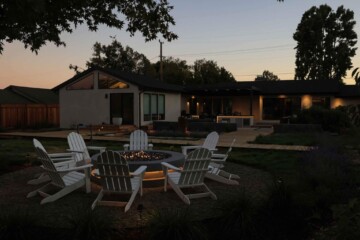
In Santa Cruz, sustainability isn’t just a buzzword—it’s a way of life. From the food we eat to the cars we drive, eco-conscious choices are a community hallmark. So why should your yard be any different? This blog will guide you through creating a sustainable, beautiful outdoor space and even share a local success story to inspire you.
Why Choose Eco-Friendly Landscaping
Environmental Benefits
Opting for eco-friendly landscaping means reducing your carbon footprint and conserving natural resources. Native plants require less water and are more resilient, contributing to biodiversity.
Economic Benefits
Sustainability isn’t just good for the planet; it’s also good for your wallet. Eco-friendly landscaping often requires less maintenance and can increase your property value, making it a win-win situation.
Key Elements of Eco-Friendly Landscaping
Native Plants
Choosing native plants is a cornerstone of sustainable landscaping. Plants like the California Poppy or Coast Live Oak are not only beautiful but also adapted to our local climate, requiring less water and care.
Efficient Irrigation Systems
Water is a precious resource, especially in California. Opt for efficient systems like drip irrigation or even rainwater harvesting to minimize waste.
Sustainable Materials
When it comes to hardscaping, consider using recycled or reclaimed wood for decks and fences. Permeable pavers for pathways allow water to seep through, reducing runoff.
A Local Success Story: Cozy Hideaway in Santa Cruz
One of the best examples of eco-friendly landscaping in Santa Cruz is a residential project by K&D Landscaping called Cozy Hideaway. This project included a variety of sustainable features:
- Concrete stepping path & gravel for low maintenance
- Fencing and gravel patios that utilize sustainable materials
- Wood decking and boardwalk made from reclaimed wood
- An outdoor kitchen and custom fire feature for year-round enjoyment
- A meadow, plant installation, and soil amendments that are eco-friendly
This project perfectly encapsulates what it means to have a sustainable yet cozy outdoor space.
How K&D Landscaping Can Help You
K&D Landscaping isn’t just another landscaping company. They’re a team committed to sustainability and guided by core values like Professionalism and Respect. Their 100% customer satisfaction guarantee means they’re not happy unless you are.
Getting Started with K&D
So how does it work? First, you’ll have a complimentary on-site meeting with an experienced project manager to discuss your vision. They’ll offer cost-effective options and keep you informed every step of the way. And if you have any questions or changes, they’re always here for you.
Eco-friendly landscaping is more than just a trend in Santa Cruz—it’s a lifestyle choice that benefits both the environment and homeowners. Whether it’s choosing native plants, installing efficient irrigation systems, or using sustainable materials, small changes can make a big difference. And with experts like K&D Landscaping, achieving your eco-friendly dream yard is easier than ever.
Ready to make your yard a sustainable sanctuary? Contact K&D Landscaping for a free quote and take the first step toward a greener future.
K&D Landscaping Residential Landscaping FAQ’s
Q: What are some native plants suitable for Santa Cruz landscaping?
A: Some popular native plants for Santa Cruz include the California Poppy, Coast Live Oak, and Toyon. These plants are well-adapted to the local climate and require less water and maintenance.
Q: How can I make my irrigation system more efficient?
A: Consider installing a drip irrigation system or a rainwater harvesting system. These methods are more efficient than traditional sprinklers and help conserve water.
Q: What are permeable pavers and why should I consider them?
A: Permeable pavers are designed to allow water to pass through, reducing water runoff and promoting natural filtration. They are an eco-friendly choice for pathways and driveways.
Q: Can you tell me more about the Cozy Hideaway project in Santa Cruz?
A: The Cozy Hideaway is a residential project by K&D Landscaping that features a range of sustainable elements like concrete stepping paths, reclaimed wood decking, and eco-friendly plant installations. It’s a great local example of how sustainability and aesthetics can go hand in hand.
Q: How does K&D Landscaping ensure customer satisfaction?
A: K&D Landscaping is committed to delivering a 100% customer satisfaction guarantee. Your journey with us begins with a complimentary on-site meeting to understand your vision. Throughout the project, we maintain open communication and adhere to our core values of Professionalism and Respect, ensuring you receive high-quality service.

